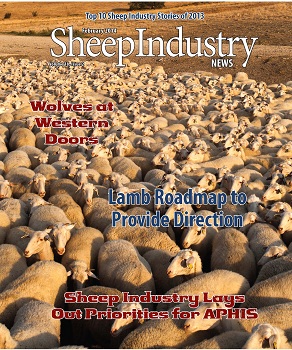
- February 2014
- President’s Notes
- Market Report
- American Lamb Industry Announces Final Roadmap
- Looking Back: Top 10 Sheep Stories of 2013
- Sheep to Shawl
- Sheep Growing Senator Weighs in on Idaho Wolf Debate
- Are Your Ewes Pregnant?
- Economist Sees Bumpy Years for U.S. Ag
- New Farm Bill May Bring Insurance Issues
- New Wool Yarn Mill Filling Niche
- College Wool Judging Teams Pick Up Skills Together at Belle Fourche Clinic
- ASI Offers Sheep Priorities to APHIS
- Utah Farm Bureau: States Can Manage Wolves
- Farmland Prices Rise, But How Long is Ride?
- Sheep Heritage Contributors
- Obituaries
Utah Farm Bureau: States Can Manage Wolves
Caleb Warnock
The (Provo) Daily Journal
Leland Hogan wasn’t pulling any punches when it came to predators.
“The Endangered Species Act, if you look at the numbers, is a colossal failure,” said Le- Hogan, president of the Utah Farm Bureau Federation, in the latest issue of Utah Farm Bureau News magazine.
There are no wolves in Utah, but that doesn’t put a damper on the debate over their potential future in the state, should they ever appear here.
The federal government has oversight of all gray wolves in the U.S. because they are listed as endangered species. Now the feds are proposing to delist gray wolves and turn their management over to states, which in Utah would likely make it legal to shoot wolves, should they cross the border.
Because wolves prey on livestock, there is no love lost between the creatures and the Farm Bureau.
There has only been a single confirmed wolf sighting in Utah’s modern history. On November 30, 2002, a wolf from Yellowstone’s Lamar Valley was captured in Morgan County and returned to Yellowstone.
Since that day, there “have been a few border incursions, as extreme northern Utah is not far from Wyoming wolf range,” said John Shivik of the Division of Wildlife Resources, who oversees the management of large predators in Utah. “There is no evidence, however, that wolves have taken up residence in Utah.” Hogan and the Farm Bureau are calling the Endangered Species Act a waste of taxpayer cash. In the UFB article, he calls wolves both “sinister” and “marauding.”
“Since its enactment in 1973, only about 20 out of nearly 2,000 endangered or threatened species – about 1 percent of the total – have been declared recovered, despite spending hundreds of millions of taxpayer dollars,” said Hogan in UFB magazine. “The draft rule being proposed by the agency would remove the gray wolf from the Endangered Species List in the continental 48 states and turn over wolf management to the states. We support the Service’s proposal to delist the gray wolf; however, we do not support listing the Mexican wolf as an endangered subspecies. In addition, Utah Farm Bureau calls on the federal government to turn management of wolves to the states.”
The Farm Bureau is not alone in its ideas for wolf management. The leadership of the Utah Division of Wildlife Resources, Gov. Gary Herbert and Utah’s congressional delegation “have repeatedly requested delisting throughout Utah,” said Shivik.
As for the Mexican wolf, their “core population did not range farther north than central Arizona and New Mexico, and Utah maintains that Mexican wolf recovery areas should not include any parts of Utah,” Shivik said.
The Mexican wolf is a unique subspecies that occurred in Mexico and parts of the southwestern United States.
Even when wolves are sighted in Utah, the state maintains some skepticism, based on experience.
“Coyotes and domestic dogs are often confused with wolves on the landscape, especially after news reports cause interest in the subject,” said Shivik. “Some people have hybrid or domestic dogs that very strongly resemble wolves, which adds to the confusion too.
Division biologists receive hundreds of reports every year, but less than 3 percent are even potentially wolves.”
Re-preinted from the Daily Herald

